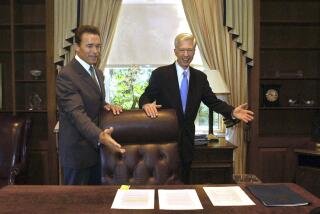Politics as It Was Meant to Be
- Share via
Each year, we reformers lament that candidates have to raise and spend more and more money to get their messages out to the voters. Candidates are forced to blitz voters with TV and radio ads because the free media virtually ignore elections. More than half the top-rated local news shows in the nation provided not a single story about the 2002 California gubernatorial campaign. Not so in the recall election.
Already, candidates for governor have appeared on the “Today Show” and NPR and have been featured or at least mentioned in major weekly magazines. Jay Leno’s “Tonight Show” has invited every candidate to be at the show in September. CNN interrupted its regular programming to show a Gray Davis press conference. (How many TV news crews showed up for a Davis event in 2002?)
No, television is not ignoring this race; it is heating it up and creating interest in it from people who never talk about politics, especially state politics.
All of this media frenzy could go away if something more exciting occurs -- such as a celebrity committing a murder. But until another “news story du jour” appears, the media will continue to focus on what many are calling the “California circus.”
And when the inevitable debate occurs, it will be covered nationwide on almost every news (and many non-news) stations -- but only if Arnold Schwarzenegger participates. It was hard to find any coverage of the last debate between gubernatorial candidates Gray Davis and Bill Simon.
What all this means is that candidates won’t be able to control the message through their own TV and radio spots as they could in the past. And they will get much more free exposure on TV and radio as well as in the print media than ever before. In all, campaign money will play less of a role for the candidates and for the voters.
According to the secretary of state’s office, Gray Davis spent more than $64 million for his 2002 reelection bid and Bill Simon, his Republican opponent, spent nearly $34 million. Neither Davis nor Simon will spend as much this year, nor will they have to.
In addition, contribution limits kick in for the first time for the governor’s race. No candidate -- other than Davis, who is not a candidate on the recall ballot -- can raise more than $21,200 from anyone, including individuals, PACs, labor unions or corporations.
Though candidates can spend as much of their own money as they want because of a U.S. Supreme Court decision, they can lend their campaigns no more than $100,000. This will prevent someone like Bill Simon, who lent his campaign millions of dollars in 2002, from going to contributors after the election and begging for funds that go directly into his pocket.
Davis, of course, is delighted that he can raise as much as he wants from anyone. In a sense, this is fair because the pro-recall, anti-Davis forces too can raise unlimited funds.
Voters should glory in this election’s news coverage. Instead of only seeing 30-second spots on TV, they will have the opportunity to read about candidates and watch them discuss their qualifications and their views on the issues that most affect Californians.
This recall could be a refreshing change from the “same old, same old” that we usually are forced to witness and that turns us off to politics. Instead of people being turned off by politics, county clerks are reporting intense interest in registering to vote and a large number of people volunteering as precinct workers.
This is the way that we had hoped elections would be: big turnout, free media, discussions around the water cooler, less emphasis on raising money and lots of ideas being debated.
So instead of lamenting the recall election, let’s celebrate it for reducing the importance of campaign money and increasing our interest in politics.
Robert M. Stern is president of the Center for Governmental Studies and was the first general counsel of the California Fair Political Practices Commission. Tracy Westen is CEO of the center and an adjunct professor of communications at the USC Annenberg School of Communications.
More to Read
Get the L.A. Times Politics newsletter
Deeply reported insights into legislation, politics and policy from Sacramento, Washington and beyond. In your inbox twice per week.
You may occasionally receive promotional content from the Los Angeles Times.









